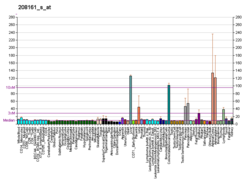Top Qs
Timeline
Chat
Perspective
ABCC3
Protein-coding gene in the species Homo sapiens From Wikipedia, the free encyclopedia
Remove ads
Canalicular multispecific organic anion transporter 2 is a protein that in humans is encoded by the ABCC3 gene.[4][5][6]
Remove ads
Function
The protein encoded by this gene is a member of the superfamily of ATP-binding cassette (ABC) transporters. ABC proteins transport various molecules across extra- and intra-cellular membranes. ABC genes are divided into seven distinct subfamilies (ABC1, MDR/TAP, MRP, ALD, OABP, GCN20, White). This protein is a member of the MRP subfamily which is involved in multi-drug resistance. The specific function of this protein has not yet been determined; however, this protein may play a role in the transport of biliary and intestinal excretion of organic anions. Alternatively spliced variants which encode different protein isoforms have been described; however, not all variants have been fully characterized.[6]
ABCC3 is induced as a hepatoprotective response to a variety of pathologic liver conditions. The constitutive androstane receptor, pregnane X receptor and nuclear factor (erythroid-derived 2)-like 2 (Nrf2) transcription factors are involved in mediating induction. A functional antioxidant response element in the 8th intron of the human ABCC3 gene appears responsible for Nrf2-mediated induction in response to oxidative stress.[7]
Remove ads
Interactive pathway map
Click on genes, proteins and metabolites below to link to respective articles.[§ 1]
Fluorouracil (5-FU) Activity edit
- The interactive pathway map can be edited at WikiPathways: "FluoropyrimidineActivity_WP1601".
Remove ads
See also
References
Further reading
External links
Wikiwand - on
Seamless Wikipedia browsing. On steroids.
Remove ads





